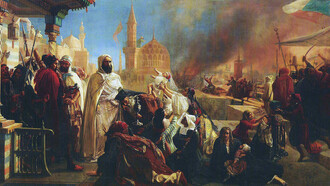Human civilization worldwide is several thousand years old. During the famous “Axial Period” in history, from about 800 to 600 BCE, scholars tell us that our evolving mental capacity led to an emerging individual self-consciousness making possible an “openness to transcendence” and, with this, the birth of today’s major world religions. These religions all flourished for the next two millennia until the so-called “Modern World” was born in the 17th century through the work of Galileo, Kepler, Newton, and others. The scientific world view that developed out of the 17th century called into question a number of religious dogmas and assumptions that were there in all the world’s religions, including Judaism, Islam, and Christianity.
People began to see the universe as autonomous from the workings of God (who was now relegated to the sole role of the Creator of things long ago). People began to see values as “merely subjective,” and not commands conveyed to human beings through revelation or natural reason. And people developed (pretty much for the first time) an historical consciousness that understood ancient cultures as having their own assumptions and presuppositions.
By the 19th century, the interpretation of ancient religious texts began to take on ever greater levels of sophistication regarding the problems of translation, interpretation, and religious understanding. Many people with advanced religious insight worked to clarify the ever-greater complexities of interpreting religious texts. Their work gave 20th century modernity some of the profoundest works of religious thought ever created as found in the writings of such figures as Martin Buber, Charles Hartshorne, Nicholas Berdyaev, Valdimir Lossky, Fritjof Schuon, Alfred North Whitehead, or Paul Tillich.
Concomitantly, capitalism continued to expand throughout the 20th century in part by creating a vast consumer culture in which the purpose of life was now to satisfy all desires for comfort, pleasure, and convenience with little time left over for formal religion as found in millions of churches, synagogues, and mosques the world over. A progressive “secularization” of society was taking place worldwide. Yet this secularization was accompanied by an inclusiveness and focus on human rights that revealed some very positive potential within the phenomenon of secularization.
Nevertheless, in the realm of philosophy and intellectual history, increasing awareness of the contextual nature of all meaning and truth claims that had led to the religious sophistication of the above named thinkers was being used by some other thinkers to challenge the traditional notion of “truth” altogether. Traditional religion had embraced a conception of truth that required sensitivity to the whole context of life – to God, human beings, and the cosmos or world. Human beings were gifted, they understood, with the physical senses, and they were gifted with logos or mind, both of which encountered the whole of human life in context.
But almost invariably, it was thought that human beings were also gifted with the “third eye,” the capacity to be aware of that which was neither physical nor mental but rather all-embracing—immanent as well as transcendent. In Christianity, from Dionysius the Areopagite in the 5th century to Meister Eckhart in the Middle Ages to Nicholas of Cusa during the Renaissance, there was the persistent theme that human beings could be directly aware of God through a direct realization—a realization beyond and embracing both the senses and the logos.
Truth arose in human awareness in these traditions as an encompassing sensitivity to the whole of existence. It was not an attempt by an isolated mind using its five senses and logical formulas to try to prove something beyond doubt to a skeptical audience. The movement of modernity from a Newtonian cosmos largely independent of God to a vast consumerism of human beings seeking pleasure and comfort to a constriction of truth down to so-called “propositions” expected to “picture” the narrow phenomena they were describing, led not only to secularism but to many in the religious communities who decried what they took to be the loss of morality, the loss of reverence, and loss of respect for the “word of God.”
The reaction in many of these religious communities – in Christianity, Islam, Judaism, even in Hinduism – was “fundamentalism.” Fundamentalism believes it is going back to the basics, to what is fundamental, beyond dispute, the true essence, but this is a gigantic error. The historical sophistication recognizing the problems of interpretation of ancient texts is here to stay. There is no such thing as an uninterpreted self-evident “truth” for any Biblical or Quranic or Talmudic passage. Fundamentalism is a refusal to reap the immense riches of modernity, riches that offer us a deeper and fuller meaning of truth. It embraces a blind regression to dogmatic and intolerant ways of thinking. In doing so it violates the very teachings of the scriptures themselves and endangers the future of human civilization.
Untranscended modernity itself has led civilization to the brink of disaster. The Newtonian mechanistic world view issued in a materialistic, consumer-oriented civilization. It simultaneously constricted the concept of truth to the idea of subjective propositions somehow narrowly matching objective states of affairs. Truth became a narrow epistemological affair, not a feature of the wonderful openness of human beings to the cosmos. The sense of the whole, the sacredness of the whole, was nowhere to be found. These developments gave us the climate crisis, two horrific World Wars, and nuclear weapons. Something was and is deeply wrong. Where in today’s world do we find peace, justice, and respect for human dignity? These values are not found in much of relativistic secular society, nor in fundamentalist dogmatism.
The way forward lies in what has been called “Constructive Postmodernism.” This is quite different from “Deconstructive Postmodernism” which has attacked the narrow idea of truth deriving from Modernity and proclaimed that all so-called truth is contextual and there is no way to transcend context to discover something objective and non-controversial. All thought and language presuppose some cultural-linguistic community and is therefore merely a perspective with no legitimate claim to objectivity. This deconstruction became very popular in academic contexts under the influence of such thinkers as Richard Rorty, Jacques Derrida, or Michel Foucault.
If modernity has narrowed the concept of truth to match the materialistic and consumerist dogmas deriving from the Newtonian world view, then the deconstructionists attacked all attempts to rescue truth by showing that sensation and logical propositions could never access anything except endless perspectives and conceptual relativism. In attempting to explain the reliance of lies and “fake news” within the US political context that got Donald Trump elected in 2016, integral thinker Ken Wilber says that this “no-truth” idea leapt out of the universities and into popular media leading to the “catastrophic wasteland” in which we are “now suspended.”
Fundamentalism clings to a dogmatic and falsified “truth” of literally embraced traditional scriptures while deconstructive postmodernity clings to a deranged and counter-intuitive idea that all truth is relative. Both ignore the immense paradigm-shift that has been taking place in the sciences of the 20th and 21st centuries that has moved advanced human thought from a Newtonian paradigm to an Einsteinian paradigm, that is, from mechanism to organic, holistic, and cosmically grounded thought and awareness. It is here that we must look for a way out of this “catastrophic wasteland.”
Holistic thought and awareness give us “Constructive Postmodernism.” This transcends both relativism and fundamentalism. Instead of reacting in destructive and negative ways to the era of modernity, as do both fundamentalism and deconstructionism, we can see the limitations of the modern paradigm and ascend in an immense spiritual and conceptual expansion to embrace the cosmos as a whole as that is revealed to us through contemporary cosmology and quantum physics. In doing so, even while transcending our present historical era, we draw upon the wisdom of traditional religions that understood truth to be the revelation of the three human “eyes” working in harmony: the senses, the logos, and the non-cognitive awareness of the whole encompassing all things, a whole that is both immanent and transcendent.
This whole, in the very nature of things, cannot be objectified. It cannot be made the object of propositions or sense data. What the 20th century discovered was holism, as revealed by physics, ecology, psychology, and innumerable sources. Both fundamentalism and relativism fragment reality and in doing so destroy the “truth that can make us free,” the Truth that was traditionally associated with God, Allah, Brahman, or the Tao. The holistic response of the whole person with all the sources of awareness at our disposal (the three eyes), gives us truth, as well as peace, harmony, freedom, and sustainability.
There is a holistic document that can allow human beings to move forward in history without destroying either ourselves or the environment. It is called the Constitution for the Federation of Earth. Written by hundreds of world citizens working together and drawing on the holistic paradigm of the 20th century, this Earth Constitution gives us a democratic Earth Federation predicated on the unity in diversity of all peoples, nations, and cultures.
To access a world of peace with justice and sustainability, we must move beyond the materialistic fragmentation that we inherit from modernity. We must move beyond consumerism, mindless relativism, and all blind fundamentalism to realize the potential that has always been at the heart of human civilization. That is the potential to be in harmony with the whole, which means at the same time to be in harmony with one another.
The very act of studying and promoting the Earth Constitution leads us to greater levels of holistic thinking and feeling. We begin to see our immense human dignity, a dignity that was recognized in the traditional religions but lost to the mechanistic world view of Modernity. The path of freedom and a redeemed human future runs through the ratification of the Earth Constitution. Let us again ascend to the truth of holism and begin to draw on the true fullness of life. Humanity can move forward beyond fragmentation and relativism by embracing this document that truly unites us in the quest of a new holistic world of unity in diversity.















